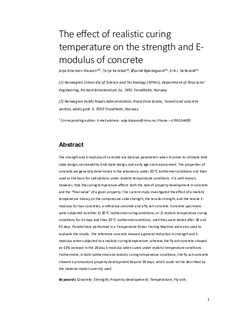| dc.contributor.author | Klausen, Anja Birgitta Estensen | |
| dc.contributor.author | Kanstad, Terje | |
| dc.contributor.author | Bjøntegaard, Øyvind | |
| dc.contributor.author | Sellevold, Erik Johan | |
| dc.date.accessioned | 2019-01-16T09:14:43Z | |
| dc.date.available | 2019-01-16T09:14:43Z | |
| dc.date.created | 2019-01-02T12:14:07Z | |
| dc.date.issued | 2018 | |
| dc.identifier.citation | Materials and Structures. 2018, 51 (6), 1-14. | nb_NO |
| dc.identifier.issn | 1359-5997 | |
| dc.identifier.uri | http://hdl.handle.net/11250/2580808 | |
| dc.description.abstract | The strength and E-modulus of concrete are decisive parameters when it comes to ultimate limit state design, serviceability limit state design, and early age crack assessment. The properties of concrete are generally determined in the laboratory under 20 °C isothermal conditions and then used as the basis for calculations under realistic temperature conditions. It is well-known, however, that the curing temperature affects both the rate of property development in concrete and the “final value” of a given property. The current study investigated the effect of a realistic temperature history on the compressive cube strength, the tensile strength, and the tensile E-modulus for two concretes, a reference concrete and a fly ash concrete. Concrete specimens were subjected to either (1) 20 °C isothermal curing conditions, or (2) realistic temperature curing conditions for 14 days and then 20 °C isothermal conditions, until they were tested after 28 and 91 days. Parallel tests performed in a Temperature-Stress Testing Machine were also used to evaluate the results. The reference concrete showed a general reduction in strength and E-modulus when subjected to a realistic curing temperature, whereas the fly ash concrete showed an 11% increase in the 28-day E-modulus when cured under realistic temperature conditions. Furthermore, in both isothermal and realistic curing temperature conditions, the fly ash concrete showed a pronounced property development beyond 28 days, which could not be described by the material model currently used. | nb_NO |
| dc.language.iso | eng | nb_NO |
| dc.publisher | Springer Verlag | nb_NO |
| dc.title | The effect of realistic curing temperature on the strength and E-modulus of concrete | nb_NO |
| dc.type | Journal article | nb_NO |
| dc.type | Peer reviewed | nb_NO |
| dc.description.version | acceptedVersion | nb_NO |
| dc.source.pagenumber | 1-14 | nb_NO |
| dc.source.volume | 51 | nb_NO |
| dc.source.journal | Materials and Structures | nb_NO |
| dc.source.issue | 6 | nb_NO |
| dc.identifier.doi | 10.1617/s11527-018-1299-4 | |
| dc.identifier.cristin | 1648468 | |
| dc.description.localcode | This is a post-peer-review, pre-copyedit version of an article published in [Materials and Structures] Locked until 5.12.2019 due to copyright restrictions. The final authenticated version is available online at: https://doi.org/10.1617/s11527-018-1299-4 | nb_NO |
| cristin.unitcode | 194,64,45,0 | |
| cristin.unitname | Institutt for konstruksjonsteknikk | |
| cristin.ispublished | true | |
| cristin.fulltext | postprint | |
| cristin.qualitycode | 1 | |
